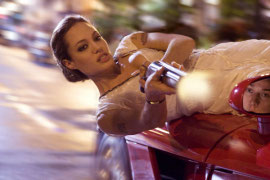 WALL·E
WALL·E
Pixar's WALL·E is the best 100 minutes I've spent at the movies this year. It may wind up being the best 100 I'll have spent at the movies all year. (The first half seems perfect, and the second half seems merely to be Pixar working at full inspiration, which is the closest thing to perfect.) Prior to WALL·E, I found it impossible to decide whether Toy Story 2 or Finding Nemo or The Incredibles was my favorite of the studio's features. Now they're all fighting for second.
Those who'd seen the film's trailers knew WALL·E was going to be cute, with its images of that heroic little worker-drone robot with the binocular eyes and squat frame and voice that suggested a stoned HAL on helium. It turns out we were all wrong; there's nothing at all cute about the film, unless you'd also consider the best of Charlie Chaplin and Buster Keaton to be "cute." With the exception of a few bits of dialogue (human and otherwise) and some extraordinary sound effects, the movie's first half is a stunningly smart and beautiful silent comedy, but one unimagined in the era of the silent era's greats - a post-apocalyptic one.
This might be the proper time to praise director Andrew Stanton (of Nemo) and his co-screenwriter Jim Reardon, because the first reel of WALL·E is as good a template for narrative economy as you'll ever find. With no dialogue, and no narration, we immediately glean the futuristic setup - an excess of garbage has made the Earth uninhabitable, and there's only one lone robot left to clean up the mess - but more importantly, Stanton and Reardon fill this world with so much detail that we understand what the setup means.
Humans are gone, but reminders of humanity are everywhere, be they the Zippo lighters and sporks that the trash-flattening WALL·E keeps in a private collection, or the VHS copy of Hello, Dolly! that the 'bot - in a stunningly sweet and sad touch - routinely swoons over, or the still-televised ads from the president and CEO of the mega-chain Buy 'N' Large (Fred Willard, in an inspired cameo), promoting the consumer conglomerate that led to civilization's downfall. And the first 15 minutes are as evocative and haunting as the introductory scenes in I Am Legend, but also funny, and far more complex and moving, than similar sequences in that Will Smith blockbuster. This isn't a world undone by a virus, but by apathy and neglect, and in the character of WALL·E, Stanton and Reardon offer a simple, honest, beautifully conceived eulogy for the trivialities we might miss most.
But for those now saying, "Well, forget that piece of environmental claptrap ... !", let me reply: "Wait! Come back!" One of the movie's many, many joys is that its themes are, with one late-film exception, never overt, and always run a distant second to the exhilarating fun that Stanton and company deliver. WALL·E eventually makes the acquaintance of EVE, a robotic research probe who's seeking (and finds) evidence of photosynthesis, and from that moment on, WALL·E becomes that specific genre hybrid that can only be called Pixar at its Best.
There's action (and more thrilling action than offered by any other summer blockbuster to date), romance (WALL·E's attempts to hold EVE's hand - learned from Hello, Dolly! - form the movie's best, most inventive touchstone), laughs (always earned), sentiment (surprisingly well-earned), wicked cleverness (with jokes about the indestructibility of cockroaches and Twinkies), wicked smarts (with the notion of humans evolving into fat, complacent consumers unaware of how fat and complacent they've become), brilliant vocal casting (Sigourney Weaver re-creates the computerized voice that drove the actress crazy in Alien), and even more brilliant effects (visualized in every moment previously unmentioned, and every moment mentioned). Computerized entertainment or not, this astounding movie, unlike many of its doomsday-scenario brethren, offers irrefutable proof why humanity is worth saving: We're occasionally able to create something as miraculous as WALL·E.
 WANTED
WANTED
Not much room left for Wanted, but the movie really doesn't need much, and that's not as big an insult as it may seem. This cinematic comic book, based on a series by Mark Millar and J.G. Jones, doesn't really have an original idea in its head; it's The Matrix by way of Fight Club. (The hard-working, engaging James McAvoy could be Edward Norton's ironic-narrator doppelgänger.) But before this jokey, effects-heavy thriller turns repetitive and uninspired - with its lead character learning the same lessons over and over again - the first half is enjoyably vicious nonsense with great throwaway moments, and Angelina Jolie, as the vixen who lures McAvoy into the professional-assassin's life, is pretty damned stunning in it. There's a magnificent scene in Wanted in which the actress, trying to make McElroy look cool in front of his shrewish girlfriend, treats him to a long, passionate kiss, and even the soundtrack silences for a moment of comic-book-geek ecstasy; Russian director Timur Bekmambetov's Hollywood debut may be unoriginal, but Angelina Jolie makes as good an argument for cloning as I've yet seen.








